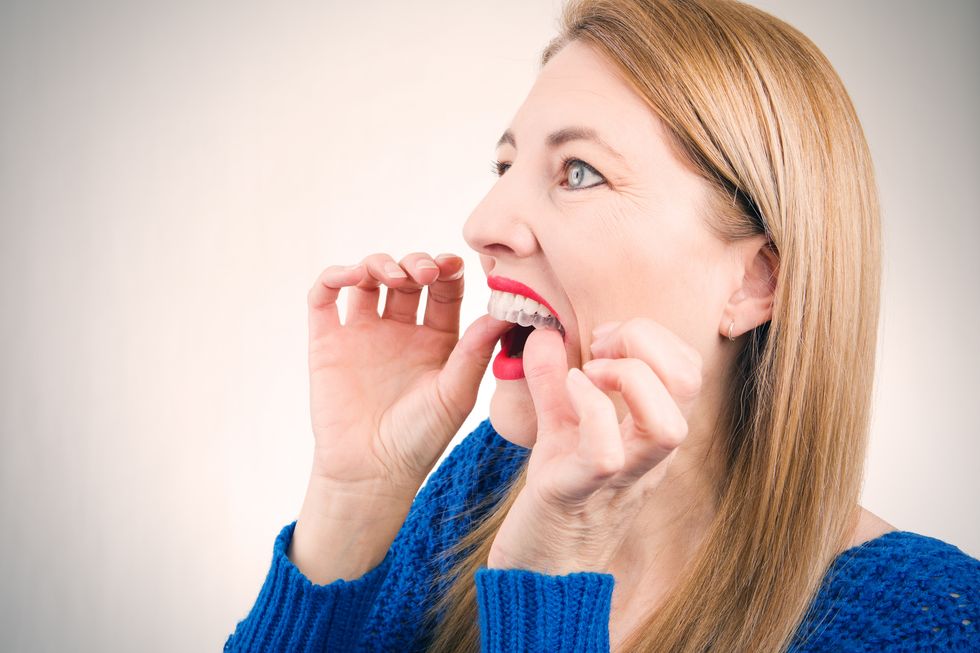
What to Do for Crooked Teeth
What to Do for Crooked Teeth
Braces aren't just for kids. As we age, our teeth shift, and some older people decide to get braces. Now there are options.
Jul 31, 2017
Jul 10, 2020
Menopause & Aging Well
Sheryl Kraft, a freelance writer and breast cancer survivor, was born in Long Beach, New York. She currently lives in Connecticut with her husband Alan and dog Chloe, where her nest is empty of her two sons Jonathan. Sheryl writes articles and essays on breast cancer and contributes to a variety of publications and websites where she writes on general health and wellness issues. She earned her MFA in writing from Sarah Lawrence College in 2005.
Full BioLearn about our editorial policies

Alligator mouth.
That's the nickname I (and others like me) was granted when, at 12, I arrived at school one day flashing a mouthful of painful and unsightly stainless-steel brackets. The constant pressure my new braces put against my teeth made me cranky, as did the restrictions they brought with them. No gum, no sticky candy like caramels, no smiling, no glamour, no fun.
Try imposing those on an already moody adolescent girl.
My mother and dentist encouraged braces to close the gaping space between my two front teeth that I inherited from my grandmother (little did I know model Lauren Hutton would soon capitalize on hers, making the look instantly glamorous and beautiful).
Aside from that, I had an offensive overbite that needed taming. Who needed buck teeth, on top of everything else?
Almost three very uncomfortable years later, I emerged with straight teeth and a perfect bite. I bid a hearty good-bye to the restrictive and tortuous metal that messed with my confidence for so long, relieved that I'd never have to face agonizing orthodonture again.
Until I did, many decades later.
Lately, I'd been noticing a change each time I ate something. Food would annoyingly get stuck between my teeth. I was constantly running to the bathroom to rinse my mouth after eating anything. Eating out became especially challenging, and I constantly worried if, when I talked or smiled, my mouth revealed bits of random food.
"Do I have food stuck between my teeth?" was a question reserved for my closest friends and family. And I made sure to always keep a mirror close in my handbag and a hefty supply of floss, too. I dared not leave home without it.
It finally registered what was happening when my dentist told me that my top teeth were looking different. "There's more space between them than there's been in the past—haven't you noticed?" he asked when I went in for my semi-annual cleaning.
Since it's rare that I examine the reflection of my own smile in much detail, no, I hadn't noticed. But when I finally scrutinized my teeth in the mirror, there it was—spaces between every single tooth.
No wonder that spinach was showing up long after I'd taken my last bite.
And then, I learned something I never knew: Our teeth shift as we age. Gums recede; bone support changes. And the only way to straighten them is to get braces.
Again.
Thankfully, now the process is so much easier (and less visible!). Too bad Invisalign wasn't around when I was younger; but hey, I'm thrilled they are now. No more (heavy) metal—now, teeth can be straightened almost invisibly with a series of customized clear aligners that fit snugly against the upper and lower teeth, minus any unsightly and uncomfortable bracket and wires.
I first learned about Invisalign years ago, and urged my husband, who never had braces as a child, to get them. He finally did, and the results were fantastic.
Now, I'm fortunate to be a part of Invisalign's "Media in Treatment" program. When I first met with Dr. Fernanda Marchi, the Connecticut orthodontist who would be treating me, she told me she has a lot of adult patients. Some, like my husband, didn't wear braces when they were younger but should have; others—like me—did wear them. "Teeth are always moving, and revert back to where they originally were," Dr. Marchi noted.
I'll be wearing my Invisalign an average of 22 hours a day—removing them to eat or drink anything other than water. Over time, my teeth will be gently coaxed back to where they belong. Time varies according to the complexity of the case; my treatment should take about three months.
One of the best things—besides being able to wear braces without detection—is I can brush and floss normally. All I have to do is remove them. Nor do they cause my teeth to ache like they did way back when. (While I do feel a tiny bit of pressure, it's totally tolerable, manageable with over-the-counter pain relievers like acetaminophen, and diminishes over time.)
Wearing Invisalign has even cut down on my snacking because I don't want to bother putting them in and out all day long (yes, I am an all-day-long snacker). It's nothing that the brand makes claim to, but if you're trying to lose weight, you might just enjoy this small perk.
But one thing is for sure: you will never see me snacking on those sticky caramels.
I broke that habit when I got my first set of braces.
If you have any questions about Invisalign, feel free to ask me in the comments section, or click here.
Although my treatment is complimentary, all opinions are strictly my own.
This post originally appeared on mysocalledmidlife.net.